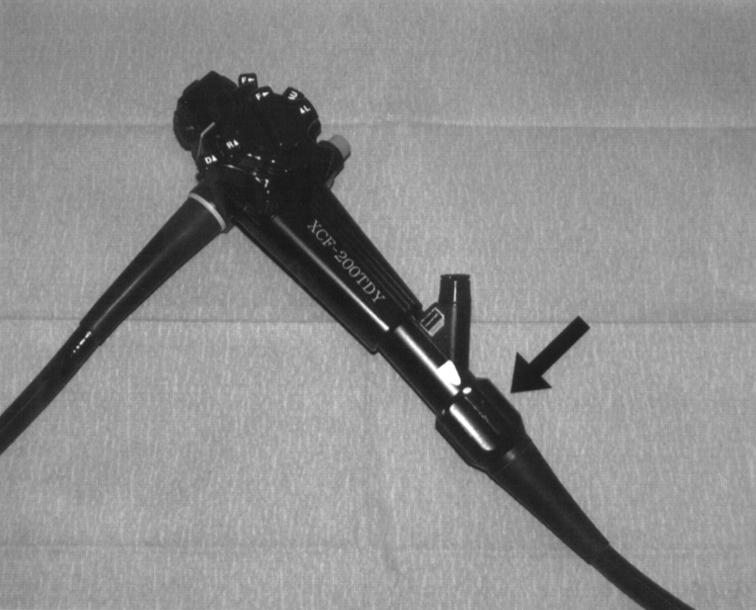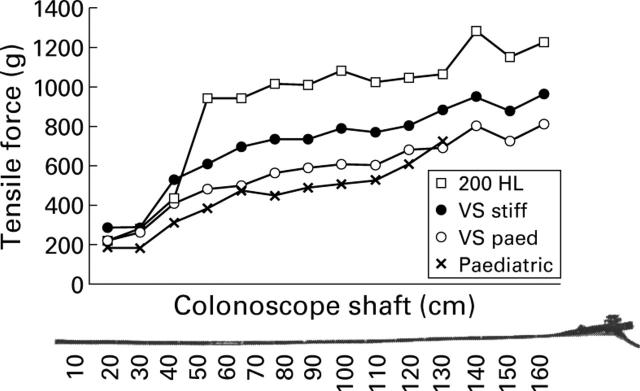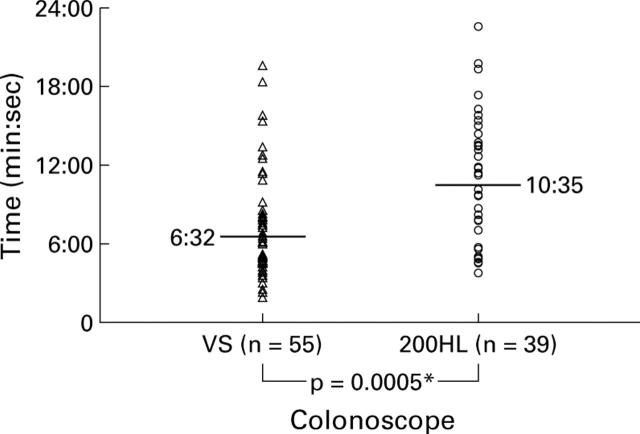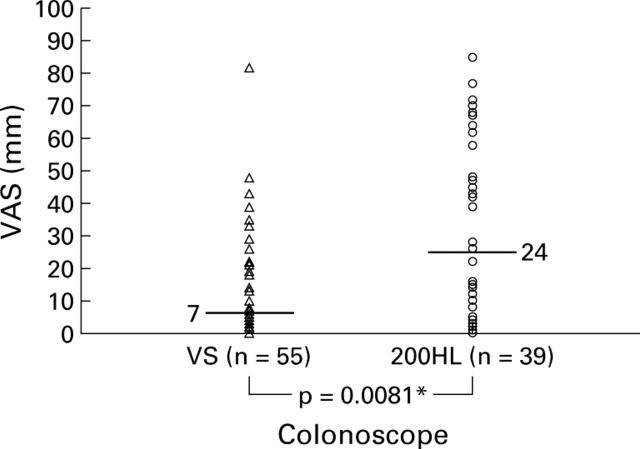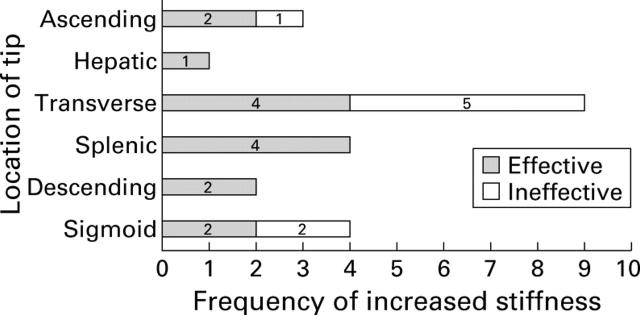Abstract
BACKGROUND—Colonoscopy remains technically difficult in 10-20% of procedures due to variable colonic anatomy and fixation. The ability to vary endoscope shaft flexibility may help insertion to the caecum. METHODS—Consecutive patients attending for day case colonoscopy were randomised to examination with either the conventional Olympus CF200HL (200HL) or a new variable stiffness (VS) colonoscope. Intubation time, use of stiffening function, and patient pain scores were compared. RESULTS—Of 100 cases, 43 were performed with the 200HL and 57 with the VS. Four incomplete examinations occurred with the 200HL (two sigmoid fixations, two benign strictures) and two with the VS (one obstructing cancer, one fixed sigmoid). Changing to the paediatric scope was successful in all but one patient from each group (obstructive lesions). Stiff mode was applied 23 times in 18 patients and was effective in 15 of these. Intubation time was quicker with the VS (median 6 minutes 32 seconds) than with the 200HL (median 10 minutes 35 seconds) (p=0.0005). Pain scores were less with the VS (median 7) than with the 200HL (median 24) (p=0.0081). CONCLUSIONS—The variable stiffness colonoscope combines paediatric shaft characteristics with the ability to stiffen when needed. This instrument significantly reduces intubation time and patient discomfort. Further comparisons should be made with the newest colonoscopes which are less stiff. Keywords: colonoscopy; colonoscopes; technology; pain
Full Text
The Full Text of this article is available as a PDF (140.6 KB).
Figure 1 .
The control head of the variable stiffness colonoscope (Olympus XCF-SH230L). The dial for controlling the stiffness is arrowed. Specifications: distal end outer diameter 13.6 mm, flexible tube outer diameter 12.9 mm, instrument channel 3.2 mm, and working length 168 cm.
Figure 2 .
The stiffness of three colonoscope shafts: the conventional colonoscope (200HL), the variable stiffness colonoscope in paediatric mode (VS paed) and at maximum stiffness (VS stiff), and the paediatric colonoscope. Stiffness was measured at 10 cm intervals along the shaft from the 20 cm mark using a tension gauge to depress each point by 5 cm when suspended across a 20 cm gap. Each value is the mean of three readings.
Figure 3 .
Caecal intubation times and median values for examinations completed with the variable stiffness (VS) and conventional (200HL) colonoscopes. *Mann Whitney U test.
Figure 4 .
Pain scores assessed using a 100 mm visual analogue scale for examinations completed with the variable stiffness (VS) and conventional (200HL) colonoscopes. *Mann Whitney U test.
Figure 5 .
Efficacy of stiffening the colonoscope shaft in overcoming recurrent looping according to the estimated location of the tip.
Selected References
These references are in PubMed. This may not be the complete list of references from this article.
- Bat L., Williams C. B. Usefulness of pediatric colonoscopes in adult colonoscopy. Gastrointest Endosc. 1989 Jul-Aug;35(4):329–332. doi: 10.1016/s0016-5107(89)72803-0. [DOI] [PubMed] [Google Scholar]
- Hull T., Church J. M. Colonoscopy--how difficult, how painful? Surg Endosc. 1994 Jul;8(7):784–787. doi: 10.1007/BF00593441. [DOI] [PubMed] [Google Scholar]
- Kitano A., Okawa K., Obata A., Oshitani N., Yoshiyasu K., Hiki M., Matsumoto T., Hashimura H., Kobayashi K. The leading cord method of colonofiberscopy. Dis Colon Rectum. 1986 Dec;29(12):882–884. doi: 10.1007/BF02555369. [DOI] [PubMed] [Google Scholar]
- Ness R. M., Gottlieb K., Rex D. K., Lehman G. A. Difficult sigmoid colon intubation: guide wire exchange technique. Gastrointest Endosc. 1996 Jul;44(1):99–101. doi: 10.1016/s0016-5107(96)70245-6. [DOI] [PubMed] [Google Scholar]
- Rex D. K., Imperiale T. F., Portish V. Patients willing to try colonoscopy without sedation: associated clinical factors and results of a randomized controlled trial. Gastrointest Endosc. 1999 May;49(5):554–559. doi: 10.1016/s0016-5107(99)70381-0. [DOI] [PubMed] [Google Scholar]
- Rogers B. H. The use of small caliber endoscopes in selected cases increases the success rate of colonoscopy. Gastrointest Endosc. 1989 Jul-Aug;35(4):352–352. doi: 10.1016/s0016-5107(89)72813-3. [DOI] [PubMed] [Google Scholar]
- Ruffolo T. A., Lehman G. A., Rex D. Colonoscope damage from internal straightener use. Gastrointest Endosc. 1991 Jan-Feb;37(1):107–108. doi: 10.1016/s0016-5107(91)70648-2. [DOI] [PubMed] [Google Scholar]
- Saunders B. P., Bell G. D., Williams C. B., Bladen J. S., Anderson A. P. First clinical results with a real time, electronic imager as an aid to colonoscopy. Gut. 1995 Jun;36(6):913–917. doi: 10.1136/gut.36.6.913. [DOI] [PMC free article] [PubMed] [Google Scholar]
- Saunders B. P., Fukumoto M., Halligan S., Jobling C., Moussa M. E., Bartram C. I., Williams C. B. Why is colonoscopy more difficult in women? Gastrointest Endosc. 1996 Feb;43(2 Pt 1):124–126. doi: 10.1016/s0016-5107(06)80113-6. [DOI] [PubMed] [Google Scholar]
- Shinya H., Wolff W. I. Colonoscopy. Surg Annu. 1976;8:257–295. [PubMed] [Google Scholar]
- Sullivan M. J. Variable stiffening device for colonoscopy. Gastrointest Endosc. 1990 Nov-Dec;36(6):642–643. doi: 10.1016/s0016-5107(90)71208-4. [DOI] [PubMed] [Google Scholar]



